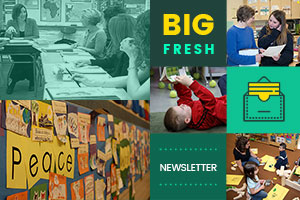Sean Maher
My favorite analogy about diving into a new role comes from Jerry Harste. One of his young colleagues, Antonio, shared the story of taking his fiancee to meet his family for the first time over Thanksgiving dinner. His fiancee was from a proper WASP family, which didn’t exactly prepare her for meeting her beloved’s boisterous clan. On Thanksgiving afternoon, they entered his grandmother’s dining room to discover the meal was already in progress.
Everyone was talking and laughing loudly. A couple dozen family members of all ages sat around the table—eating, chatting, and yelling out to each other. There weren’t enough seats for everyone, so a few adults hung back, waiting for a seat to open up.
At one point, an elderly relative took a seat after someone had finished eating. The man took a handkerchief out of his pocket, wiped the plate clean, filled it with food, and began eating. Antonio’s fiancee watched in horror. He explained, “That’s the way it is here. If you are waiting for an invitation, it is not coming. But you are welcome at the table. You just have to grab a seat when it is ready, prepare your place, and dive in.” And eventually, that’s what they both did.
Jerry told this story years ago as an analogy to trying out whole language instruction in your classroom. If you expected a neat plan or step-by-step process, you would be sorely disappointed. But if you were willing to dive in, cleaning up a few messes along the way, you could find yourself in a lively and exciting community.
I think this analogy also holds true for any big move a teacher makes. I am always surprised each summer at how many of the Choice Literacy writers are transitioning to new roles—from literacy coaching back to the classroom, from being a reading specialist to curriculum supervision. Even classroom teachers are transitioning in fundamental ways—from kindergarten to fifth grade, or middle to high school. It’s a fact of life if you’re an educator that you’re going to move. Sometimes it’s a choice—to stay fresh or learn something new. And sometimes it’s foisted on you, because of a change in district planning or needs.
Our hope is we can spend the summer developing the perfect lesson plans, ice breakers, and room designs for a smooth launch in a new role. But the truth is, at the start we’re often going to have to clean up a mess or two that someone else made. We’re going to be jumping into a new community as a stranger, and the only way to join the conversation and become a part of it is to hop in and hope for the best. So, plan away and organize for the transition. Realize at the same time there will be no easy way to jump right into it. And that’s part of the fun.
This week we look at ways to connect and build community early in the year. Plus more as always—enjoy!
Brenda Power
Founder, Choice Literacy

Deb Gaby builds the classroom community and helps students transition back to school with minilessons that give children a strong sense of the purpose of literacy workshops.
Franki Sibberson uses an “I Used to and Now I” format for a minilesson early in the year to place herself in the classroom community of readers.
Sarah Fillion visits many classrooms with beautiful displays of strategies, rules, and expectations on the walls. The problem is that students aren’t using them. She works with teachers to create a messier but more meaningful process of working with students to create wall charts together.
We’re launching two courses soon to help you get organized for the new school year. Gradual Release of the Classroom Library with Bitsy Parks will help classroom teachers design minilessons and strategies for introducing students to the classroom library over time. Getting Organized for Literacy Coaching with Ruth Ayres will help new and veteran coaches design thoughtful coaching programs. If you’re a Choice Literacy member, you’ll receive 20-40% discounts off the course fees.

New members-only content is added each week to the Choice Literacy website. If you’re not yet a member, click here to explore membership options.
Tara Barnett and Kate Mills start with the poem “Where I’m From” to build community through literacy at the start of the year.
In the end classroom, management often comes down to students valuing the same things we do. Jen Schwanke has tips for how high school teachers can create a culture where there is better communication and more shared values.
Christy Rush-Levine’s eighth graders lead their classmates in a “voices” mantra. This shared chant created together starts each class with a sense of community and strength.
In an encore video, Katie Doherty leads her sixth-grade students as they try the prompt “I am the one who . . .” during writing workshop. This is an excellent activity for building classroom community.

Lead Literacy now has a new home as the Leaders Lounge at Choice Literacy. We’ll be posting the new content updates here in the Leaders Lounge section of the Big Fresh newsletter.
Stella Villalba shares why it is important to renew a teaching community early in the year by reconnecting to everyone’s evolving goals and values.
Learning new things is sometimes hard, if only becomes it brings out our vulnerabilities and insecurities. This is particularly true for leaders, who are supposed to know everything already. Matt Renwick uses the experience of learning to build a fence to model learning for teachers.
These 16 steps can serve as a checklist for how well you are building a coaching culture in your school or district.
Quote It:
There is no power for change greater than a community discovering what it cares about.
Margaret J. Wheatley
That’s all for this week!



